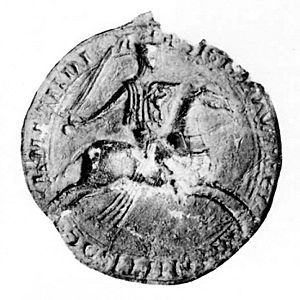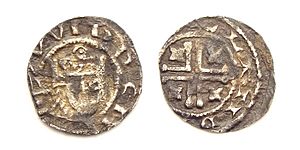William I, Count of Holland facts for kids
Quick facts for kids William I |
|
|---|---|

Effigy of William on his seal
|
|
| Count of Holland | |
| Reign | 1203 – 4 February 1222 |
| Predecessor | Ada |
| Successor | Floris IV |
| Born | c. 1167 The Hague |
| Died | 4 February 1222 |
| Burial | Rijnsburg |
| Spouse |
|
| Issue and others... |
|
| House | Holland |
| Father | Floris III, Count of Holland |
| Mother | Ada of Huntingdon |
| Religion | Roman Catholicism |
William I (born around 1167, died February 4, 1222) was an important ruler known as the count of Holland. He ruled from 1203 until his death in 1222. William was the younger son of Floris III and Ada of Huntingdon.
Early Years and Becoming Count

William was born in The Hague, a city in what is now the Netherlands. He grew up far away in Scotland. When he was younger, he joined the Third Crusade, a big religious journey and war. He went with his father, Floris, and his uncle, Otto.
Later, William had a disagreement with his brother, Dirk VII. After they made up, William became the count in Friesland, a region that was seen as part of Holland. In 1203, his niece, Ada, was supposed to become the ruler of Holland. But William did not agree with this.
This led to a fight for control called the Loon War, which lasted from 1203 to 1206. Ada and her husband had support from some powerful church leaders and other counts. However, William had the support of the duke of Brabant and most of the people in Holland. In the end, William won and became the count of Holland.
William's Time as Count
In 1203, Emperor Otto IV recognized William as the count of Holland. This was because William supported Otto's side in politics. However, after a big battle in 1214, William and many others changed their support to Emperor Frederick II.
William also joined a French military trip against King John of England. Because of this, the pope (the leader of the Catholic Church) temporarily removed him from the church, a process called excommunication. To get back into the church, William became a very dedicated crusader. He fought in wars in Prussia and was known for being brave and sometimes reckless in battle. People even called him William the Crazy because of his daring actions.
On his way to Egypt, William led a group of crusaders from different regions. They helped the Portuguese army capture the city of Alcácer do Sal from the Almohads, a group of rulers in North Africa and Spain. William also helped conquer the city of Damietta during the Fifth Crusade.
Changes in Holland
During William's rule, the land in Holland changed a lot. Many people bought swampy land to turn it into useful farmland. These new lands were called polders. Large projects were started to manage water. For example, a big island called Grote Waard was surrounded by dikes, and a dam was built at Spaarndam.
New groups called water boards were created. Their job was to protect the polders from floods, which were a constant danger. Count William also gave special "city rights" to several towns. He gave rights to Geertruidenberg in 1213, Dordrecht in 1217, and Middelburg in 1220. He might have also given rights to Leiden. These city rights helped trade grow and made the towns more important.
William's Family
Count William was married two times. His first marriage was in 1197 to Adelaide of Guelders. She was the daughter of Otto I, Count of Guelders. William and Adelaide had five children:
- Floris IV (1210–1234), who became the next count of Holland after William.
- Otto (died 1249), who later became a bishop.
- William (died 1238), who helped rule Holland for a short time.
- Richardis (died 1262).
- Ada, who became an abbess (a leader in a monastery) in 1239.
Adelaide passed away on February 12, 1218, while William was away on a crusade. In 1220, Count William married his second wife, Marie of Brabant. She was the widow of Emperor Otto IV.

